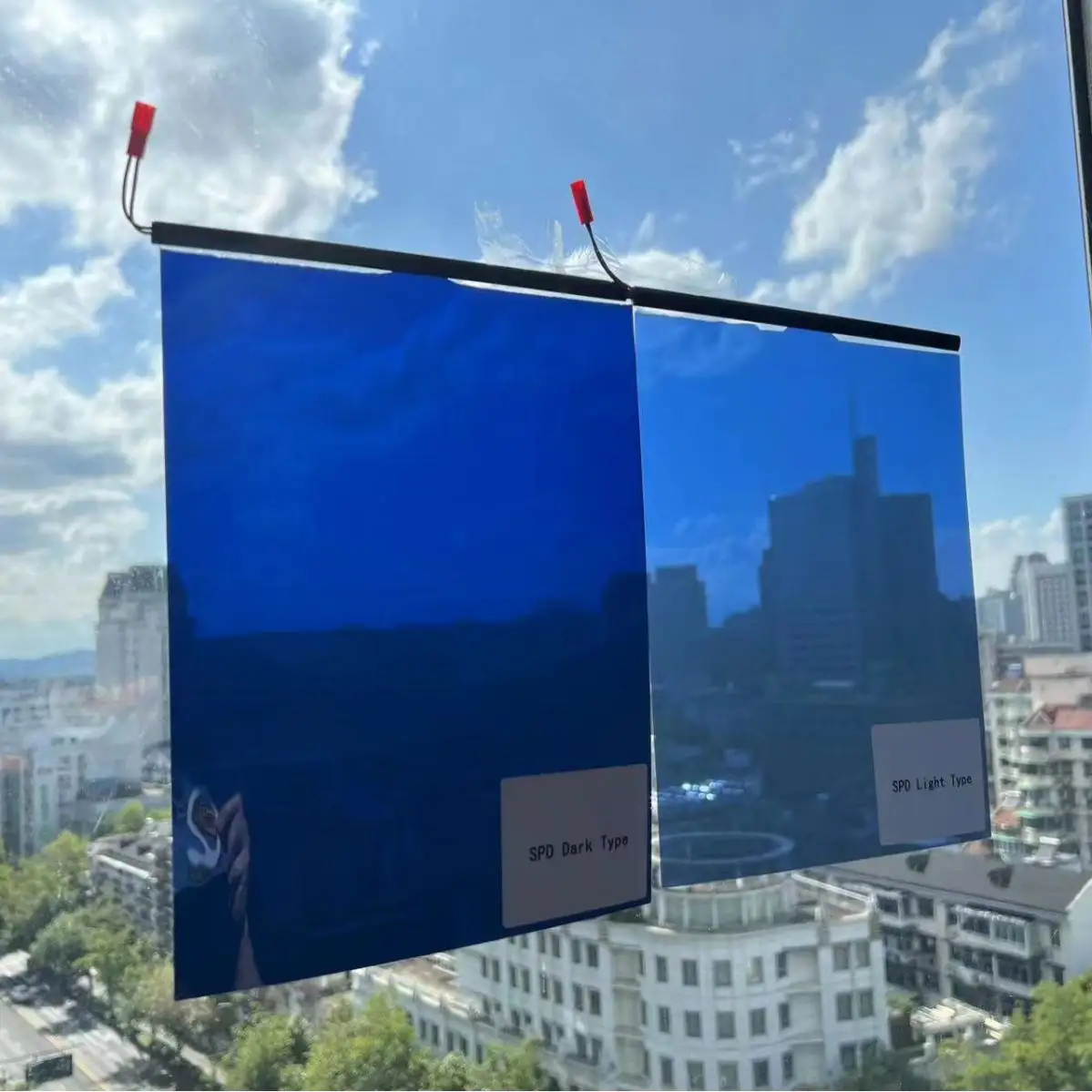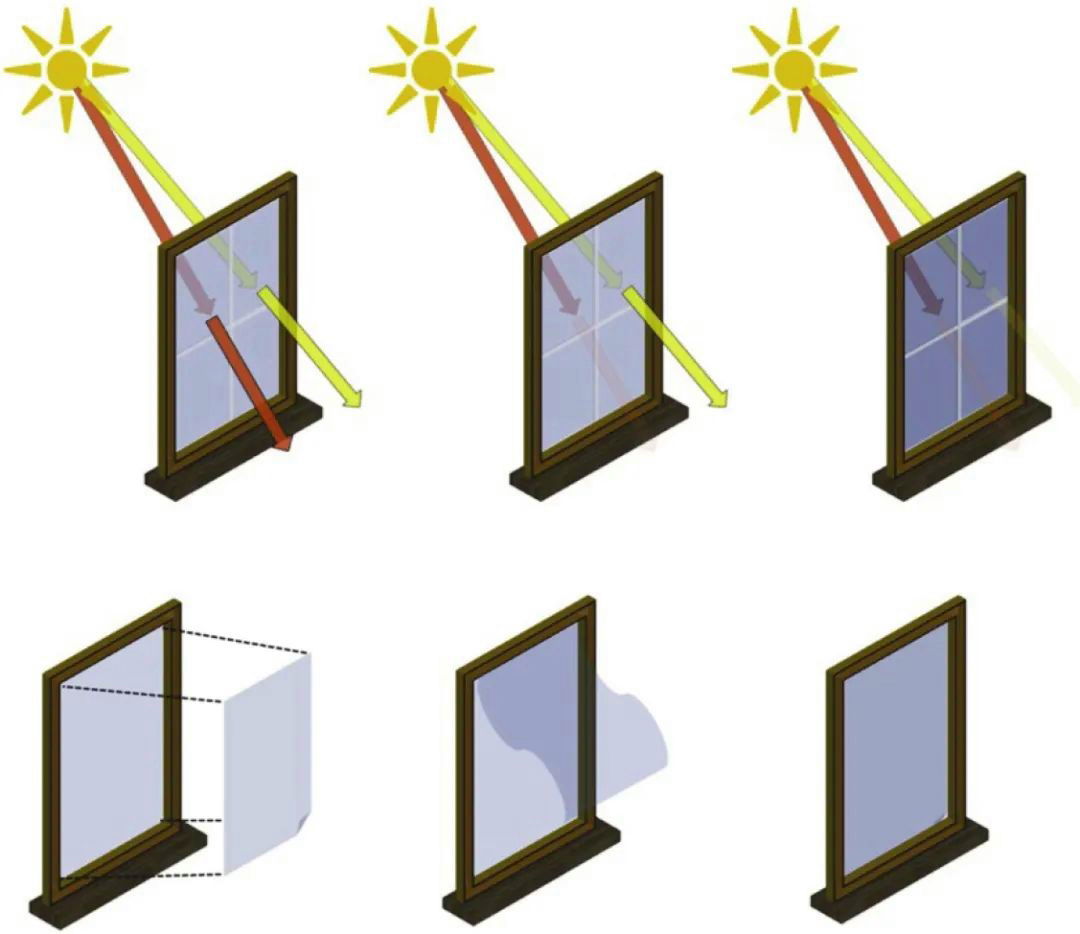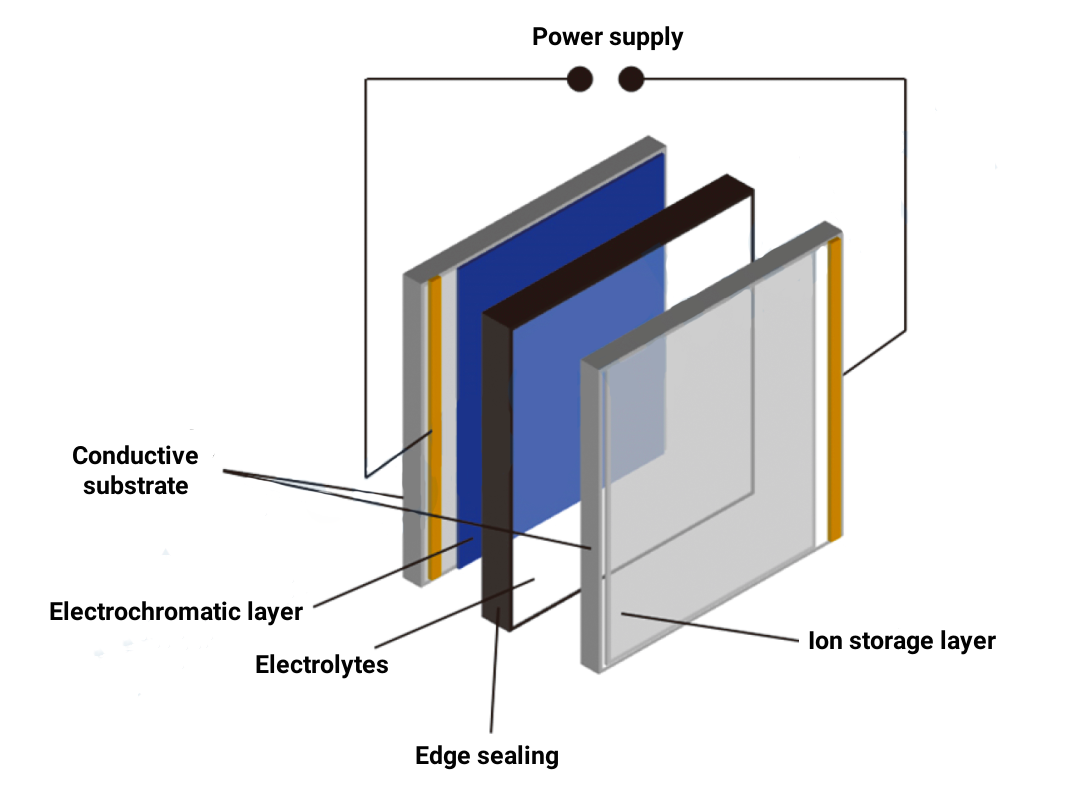The technical status, research, and development of electrochromic glass.

Normally, glass is transparent, and visible light can pass through, allowing lighting or other purposes to be achieved on the inside of the glass. In order to prevent the sun's rays from being too strong and avoid harm to the human body such as ultraviolet rays in the sun, through technical means, humans have created anti-UV color-changing glasses by coating the glass to reduce the Low-E of infrared rays and solar radiation entering the building Low-E glass. But these are all passive, or unadjustable.
Can glass be able to adjust the entry of external light at will according to people's actual needs? Can we no longer customize curtains at home? We can control ultraviolet rays and solar radiation from entering the room during the day, but prevent the outside from seeing the room at night?
What is electrochromic glass
Electrochromic glass can achieve these functions. As early as half a century ago, some scholars proposed the concept of electrochromic glass.
Electrochromic technology refers to the reversible color change of materials with electrochromic properties under the action of an external electric field, causing reversible changes in the valence state and components of the material, and improving the optical properties (reflectivity, transmittance) of the material. , absorption rate, etc.) changes or remains changed. The combination of electrochromic technology and glass, that is, electrochromic glass, can achieve active regulation of light transmission or absorption under the action of an electric field, thereby selectively absorbing or reflecting external thermal radiation and preventing indoor heat loss, thereby reducing The purpose is to control temperature and energy consumption while improving indoor light comfort. The most widely used inorganic electrochromic material is WO3, with a typical structure ITO|WO3|LiNbO3|V2O5|In2O3. Glass electrodes use transparent conductive materials, of which ITO film is the most widely used.
The structure of electrochromic glass from top to bottom is a protective layer, a transparent conductive layer, an electrochromic layer, an electrolyte layer, an ion storage layer, a transparent conductive layer, and glass, as shown in the figure.
Figure 1 The electrochromic glass
A building's indoor comfort and energy needs are strongly affected by windows. Unlike traditional static shading devices, electrochromic (EC) systems can adjust the optical transmission characteristics of the visible and/or near-infrared (NIR) regions according to specific conditions, that is, light transmittance and energy transmittance, as shown in Figure 1 Show. Therefore, they provide shade while still allowing you to see outside without requiring parts to be moved or exposed to harsh weather conditions.
Figure 2 The light transmittance and energy transmittance of electrochromic glass
In this case, the coated glass must be able to switch the total energy transmittance (g-value) in the widest possible range at a low U-value (heat transfer coefficient) according to DIN EN 410. Active switching of the EC layer system can be performed manually or automatically based on changes in facade illumination or indoor temperature. The latest approach aims to upgrade existing glass, as shown in Figure 1, using EC film.
2. Structure of EC glass
In the field of color-changing materials, EC materials are the most widely used in technical applications because they have several advantages, especially in terms of low switching voltage and ideally only dissipating electrical energy during the switching process. As shown in Figure 2, the EC element consists of an EC layer and an ion storage layer, which are respectively coated on a conductive transparent substrate. The two electrodes are separated by an electrically insulating electrolyte that conducts ions. Optical properties can be modulated by redox reactions triggered by external voltages. In addition, different colors can be achieved, as well as high transparency and low light scattering with appropriate material selection.
Figure 3 The structure of electrochromic glass
3. Historical and commercial products
“Smart window” products have been marketed in the glass and coating industries for decades, but until today, only a few products have been commercially available. In 1987, Gentex successfully industrialized the production of automatic dimming car rearview mirrors. This product is still the most successful EC product today. In addition, Gentex-PPG Aerospace developed the world's first aircraft cabin EC windows for the Boeing 787 Dreamliner aircraft, which have been in use since 2009. In the automotive field, Saint-Gobain developed a sunroof based on EC technology for Ferrari, although it has always been a niche product.
EC windows for architectural glazing are mainly developed based on inorganic (metal oxide) systems. In addition to Saint-Gobain, Guardian Industries Corp., View Inc., and Kinestral Inc., these products are commercially produced in Germany mainly by EControl-Glas. In all of these developments, thin EC layers coated on transparent conductive glass have been used, the production costs of which remain relatively high due to the cathode sputtering process employed, thus far hindering widespread market application.
4. Application cases
Swedish company ChromoGenics has developed an alternative to EC glass using a roll-to-roll (R2R) process to manufacture polyester-based EC films (ConverLightTM). With this "intelligent" shading system, glass curtain walls can be upgraded. This aftermarket application offers the unique properties of high flexibility and safety, lightweight, low operating voltage, and high color contrast. As such, they offer an alternative to traditional anti-glare devices and sunshade glazing. LIJIANG Glass do believe that how to use automated equipment for electrochromic coating on glass will be one of the key issues for glass manufacturers.
In the field of thin-film-based EC components, the EU project EELICON has also conducted research. The advantages of EELICON technology include high optical contrast (50-55%) in the deep blue dark state and almost colorless bright state, fast switching times (<30 seconds in DIN A3 size), and excellent stability under laboratory conditions. High cycle stability (>150,000 switching cycles). Argil Inc.'s EC films have similar optical properties. Another company active in this space is iGlass Technology, which has partnered with WISP Inc. to make traditional anti-glare devices obsolete. However, their prototypes are currently still in the development stage.
Overall, the advantage of post-installation applications is that the EC film can be adhered to the inside of the window afterward, so the costs are significantly reduced compared to reinstalling switchable glass.
Table 1 presents an overview of existing switchable EC component technologies and their important parameters.
| Manufacturers | Visual transmission Tv (%) | g value (%) | Switching time | Size | |
| Based on glass raw materials | EControl-Glass | 55/10 | 40/10 | 10-15min | 1.4*3.3m2 |
| Saint Gobain/SageGlass | 55/2 | 38/9 | 10-15min | 1.5*3m2 | |
| View | 58/1 | 40/9 | 10-20min | 1.8*3m2 | |
| Based on glass film | Chromogenics | 65/17 | 59/38 | 5-15min | 1.5*4.4m2 |
| Frauhofer ISC | 65/5 | 34/18 | 1-2min | 0.5*1m2 | |
| Argil Inc. | 60/10 | - | 0.5-2min | 20*20m2 | |
| iGlass Tech. | No value specified | ||||
5. Summary and outlook
Static glazing hardly meets individual and flexible requirements for daylight supply, anti-glare, and thermal comfort. Actively controllable glazing therefore has the potential to match the daylight supply a room needs while avoiding uncomfortable indoor temperatures and glare. As a result, there have been active efforts over the years to achieve market maturity by using switchable glass to regulate light and energy input in buildings.
However, there are still challenges in bringing switchable EC components to the wider market. These challenges mainly include reducing costs, finding new materials with high tinting efficiency and different colors, and avoiding electrochemical, thermal, and photochemical degradation phenomena. A high degree of UV and temperature resistance is crucial as EC glass should have a service life of at least 20 years, equivalent to more than 100,000 cycles.
References:
[1] DIN EN 410:2011 Glas im Bauwesen – Best immune system and strahlungsphysikalischen Kenngrößen von Verglasungen Beuth Verlag GmbH, Berlin.
[2] R. J. Mortimer, Electrochimica Acta 1999, 44, 2971–2981.
[3] A. W. Czanderna, D. K. Benson, G. J. Jorgensen, J. G. Zhang, C. E. Tracy, S. K. Deb, Solar Energy Materials and Solar Cells 1999, 56, 419–436.
For more information about insulating glass processing equipment and insulating glass processing accessories, please click here to learn more.





